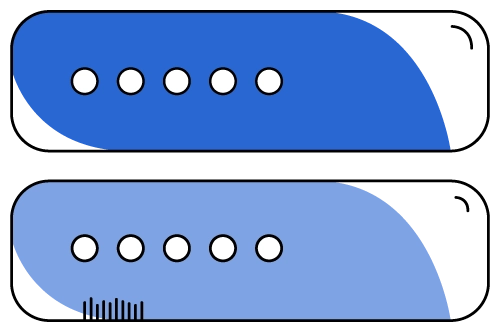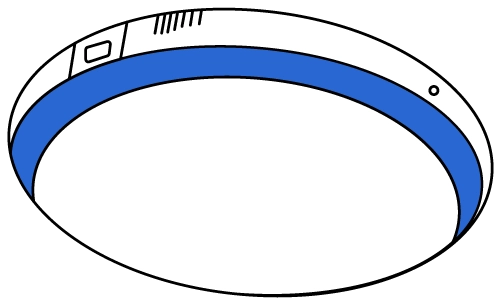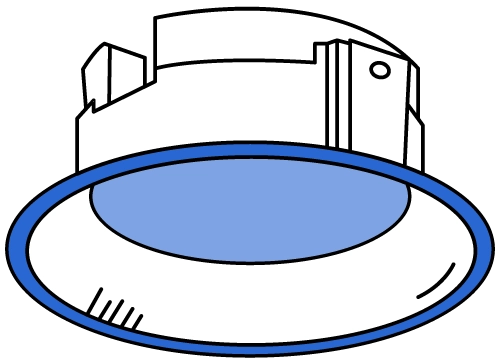LiFi technology
Wireless, fast, secure
LiFi (for Light Fidelity) is a bi-directional optical communication technology that enables high-speed data transfers without the need for radio waves.
What is LiFi?
Resulting from years of extensive research, LiFi is an innovative technology for converting light into data. The data transmission is done by the modulation, invisible to the naked eye, of a light signal emitted by LEDs.
The signal circulates between a transmitter device (Access Point or Repeater Antenna) equipped with LED bulbs, and a receiver (Dongle) connected to the connected devices. Though the use of an external receiver is still required for most devices, Oledcomm has created the first casing for tablets integrating a LiFi receiver, and thanks to the miniaturization of the technology, all devices (computers, smartphones, tablets …) will soon integrate the LiFi technology natively.
Ultra-fast, healthy, stable and secure, LiFi is becoming a flagship technology in the world of telecommunications
The advantages of LiFi
Up to 50% energy savings compared to a Wi-Fi solution
Routers, modems, repeaters… WiFi requires energy-intensive electronic devices that are often left on all the time.
Because of the energy efficiency of the LED bulbs used to operate it, LiFi inherently consumes less energy than WiFi, and therefore saves on electricity bills.
Fast and stable connectivity for multi-gigabit speeds
Since the spectrum of visible light is 10,000 times wider than that of radio waves, the volume of data transported in a given time via LiFi can be much greater than via WiFi. In addition to its economic and ecological qualities, Oledcomm’s LiFi solutions are therefore particularly efficient, and offer a speed of up to 5 Gbps, a connection speed that allows full advantage to be taken of everything the Internet has to offer (downloading, streaming, video games, online courses, collaborative tools, etc.) or to transmit data point to point.
Absolute security thanks to the partitioning of the data in the broadcasting area
In a world where the most sensitive business is handled electronically, cybersecurity has become a major issue to which current technologies have not provided a decisive answer. History has proven that the radio waves emitted by WiFi, because they can penetrate walls, don’t allow governments, law firms or embassies to handle confidential files with absolute security. Our optical communication solutions, by broadcasting data via light, don’t go outside a defined area and allow a connection strictly limited to the area in which they are installed. In essence, LiFi is not interceptable, and provides an extremely robust connectivity solution in terms of cyber security.
Wireless and space-saving technology thanks to cable replacement
Because it’s directly integrated into infrastructures, the installation of a LiFi system doesn’t involve the dangerous and impractical cable clusters that are still common. More aesthetically pleasing and safer, this installation without visible cables is also a major asset in aerospace and defense.
Indeed, it is estimated that WiFi equipment on board an aircraft weighs an average of 1.3 tons due to the shielded cables used to prevent electromagnetic interference. Without radio waves, there is no need for shielded cables, and without shielded cables, the weight of the communication system can be cut in half, resulting in significant energy and budget savings.
A non-harmful data transmission system because it doesn't use radio waves
The omnipresence of radio waves in our daily lives is raising more and more questions. Although still undefined, the impact of near-permanent exposure to radio waves on the brain and on the development of diseases is of concern, and the need for a connectivity solution without radio frequency pollution is being felt. Because it doesn’t use radio waves, LiFi connectivity is completely harmless, and provides a concrete answer to a central issue in the future of Internet connection.
Uniform, latency-free coverage even when multiple users are connected simultaneously
One of the main purposes of LiFi is to overcome the flaws of WiFi. And among these, its vulnerability in dense environments is top of the list. Once a certain number of users are connected to the same WiFi access point, connectivity deteriorates and data transfer becomes slower. Conversely, LiFi is designed to work optimally and without latency, even in areas of high congestion. In fact, each LED LiFi light bulb can provide an ultra-fast connection to all users within its coverage area. Since the densest environments are usually equipped with multiple light sources, everyone can have optimal connectivity from one of the multiple access points.
Oledcomm LiFi
How does it work?
Oledcomm, a pioneer in LiFi, has developed the LiFiMAX solution, a system consisting of a transmitter device integrated into the LED bulb, called Access Point, repeaters (Photonic Antennas) and a receiver device connected to the connected device, called a Dongle.




antenna
(repeater)


zone




Access point
LiFi signal transmission
What we call an Access Point is a LiFi router connected to the Internet through an RJ45 Ethernet cable with PoE capability, integrated in a LED light bulb. The Access Point receives the information from the network as an electrical signal, and then it’s translated by the switching of the LED bulb.
The bulb emits a light beam whose intensity varies tens of thousands of times per second, so fast that this oscillation is perfectly invisible to the naked eye.
LIFI DONGLE
LiFi signal reception and processing
The connected device to which the dongle is connected or in which the LiFi chip is integrated, when it’s located in the coverage area of the light beam, receives the data emitted by light oscillation. The reception and processing of Internet data is made possible by the presence, in the Dongle, of a photodiode that captures the light signal and a processor that translates it into a binary system to make it understandable by the computer, smartphone or tablet.
LiFi use cases

Defense & Security
Oledcomm LiFi also has significant benefits for the defense industry, which is still forced to access the Internet via bulky cable systems to meet its demanding cybersecurity needs.
In fixed environments (buildings, offices, laboratories or crisis rooms), a militarized version of LiFiMAX offers users the advantages of mobile connectivity and avoids the ergonomic constraints of cable while enjoying optimal security.
Thanks to LiFi, mobile command posts, which often have to relocate in an emergency, can enjoy an ultra-secure wireless Internet access system that can be deployed and redeployed in just a few hours.
This LiFi equipment also exists in an embedded version to equip vehicles or any other mobile object with a reliable, fast, secure and interference-free connection.
In addition to the Internet connection, LiFi also enables point-to-point communication,
with ultra-fast data exchange. It’s also a reliable and efficient way to exchange tactical data (reports, security alerts…) between a mobile boat and a control station.
Aerospace
As connected devices continue to shape the industry of the future, the aerospace industry faces a major obstacle: interference from these devices on critical cockpit equipment, which can hinder the proper functioning of the aircraft and even endanger the lives of crew members. LiFi, because it operates without radio frequency waves, doesn’t pose any risk of electromagnetic interference, and provides optimal connectivity in flight, in complete safety.


Secure offices
Cybersecurity is at the heart of our approach. Rather than using radio waves, LiFi uses the near-infrared light spectrum to transmit and receive data. Light has a significant advantage – it doesn’t pass through walls. The use of light to exchange data therefore makes it possible to physically secure connectivity within a defined area. LiFi is therefore, by nature, unhackable, undetectable and non-jamming, thus ensuring the absolute security of your connectivity. To ensure additional security, Oledcomm has developed the LiFiMAXController®, a program integrated to the access point allowing the management and the complete configuration of your network infrastructure.
Industry & Transportation
Wireless, interference-free and allowing highly accurate geolocation, LiFi technology has many advantages for the transportation and industrial sectors. While its merits were already being touted in the aeronautical and aerospace industry, it’s equally suited to land-based transportation systems such as trains, city transit systems and cars. The development of LiFi in the industrial and transportation sectors is still in its infancy, but we can already imagine multiple ways to benefit from this technology. For example – fast and stable Internet connection during trips, warning systems in case of imminent collision, exchange of information on traffic or road conditions, equipment of traffic lights to make traffic flow more smoothly, suggestion of routes in real time, etc.


Education
Education in schools is increasingly capitalizing on digital technology, and this trend has opened up new educational opportunities. However, concerns about the effects of radio waves on young people remain, and the use of WiFi in these environments is now highly regulated. LiFi is therefore an obvious and healthy alternative to WiFi in schools, not only because it’s free of radio waves but also because it’s much more suitable for use by many people simultaneously without latency. In addition, it is space-saving and can be integrated into existing lighting systems.
Customized
At Oledcomm, our expertise allows us to push beyond the limits of LiFi applications. Whatever your ambitions and constraints, we can imagine, design and install a LiFi solution that meets them.

LiFi vs WiFi
Rivalry or complementarity?
Network saturation, interference problems, potential toxicity of radio waves, limited coverage and insufficient security, the flaws of WiFi and 4G / 5G are numerous and represent a major obstacle in a context where a growing proportion of our daily functions depend on the Internet.
The advent of alternative wireless communication technology that could overcome the limitations of conventional technologies was therefore a necessity, and LiFi was developed in response to this need.
“LIFI TO OVERCOME THE LIMITATIONS OF CONVENTIONAL TECHNOLOGIES”
“LIFI WASN’T CREATED WITH THE OBJECTIVE OF ERADICATING WIFI”
But contrary to what we may sometimes read or hear, LiFi wasn’t created with the objective of eradicating WiFi. It’s above all about extending the field of possibilities in the field of telecommunication, of thinking about the connectivity of today and tomorrow by freeing ourselves from the obstacles of current technologies without depriving ourselves of their benefits.
In the long term, we can imagine that LiFi will be preferred to WiFi wherever radio waves are undesirable, whether for health or interference reasons, that it will develop in the most demanding sectors in terms of data security, such as defense and governments, and that it will be an integral part, along with other complementary technologies, of the digital landscape of tomorrow.
Home > Our technology